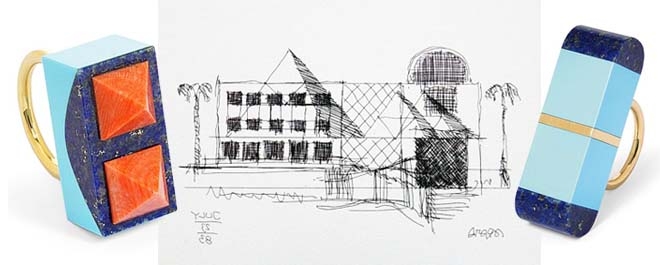Arata Isozaki – Star architects and their Jewelleries – Part 4
Anyone who has already been to Japan, probably agrees with me, that Japan is the perfect combination of past and high-tech. Arata Isozaki, the famous Japanese architect is the next character of my series about star architects and their jewelleries. Just like the previously introduced architects, his jewelleries are mini-architectural models.
Arata Isozaki 1931-
Arata Isozaki graduated from University of Tokyo where he majored in Architecture and Engineering. He was Kenzo Tange’s, the Pritzker Prize-winning architect’s student and later they worked together. He established his own firm in 1963. His early projects were influenced by European experiences. In his projects he created a perfect blend of traditional Japanese architecture and modern techniques. Later on the postmodernism characterized his art. In 2005, he founded an office in Italy, Arata Isozaki & Andrea Maffei Associates. He is a professor at several major US universities.
Arata Isozaki’s jewelleries and buildings
He started to design jewelleries by Cleto Munari’s request (designer and entrepreneur). This is how he could be a member of the architectural dream team. They designed jewelleries for the Italian company in the 1980s. At this time he designed postmodernist buildings. Of course these jewelleries had clear mark of this style. He said that he had created jewelleries by using vaults, cubes, pyramids and cylinder. Everything he dealt with was the extension of his architecture. He never wanted to be a jewellery expert. Despite of designing very special subjects for women, his wife did not wear his jewelleries, because they didn’t match her style. She dressed in a much more moderate manner. He thought his pieces were for women who were a little bit crazy. While designing jewelleries he thought that with his tiny artworks he could bring a little magic to ladies’ lives when they were wearing some of their jewelleries. His jewelleries were made of precious materials, such as gold, lapis lazuli, turquoise, red agate or red coral. One thing to note is that his jewelleries really reflected on the forms of his buildings.
He designed his curved ring with Cleto Munari in 1984. Earlier he planned some similar twisting formed buildings, like a library or a golf club.
The semi-cylinder motif on the top of the ring is familiar from his previously planned buildings.
Pyramids and Pyramids!
Who would think that after the pharaohs' time pyramids can be blended with modern materials and stylistic characters especially when they are placed on a ring.
The grids, semicircle and square motifs on the beautiful pendant were also featured in his previous plan.
The cylinders are frequent elements of his works. But he used them in so many ways that we don’t have the feeling that he repeated them so often. Each time he gives us a new idea and a new phenomenon.
If you are interested in the previous parts of Star Architects and their Jewelleries series, read my previous blog posts:
Zaha Hafid - Part 1
Frank Gehry - Part 2
Hans Hollein - Part 3
If you are interested in what kind of jewelleries I design as an architect, visit my homepage.
Find jewellery photos here and here and building photos here.


